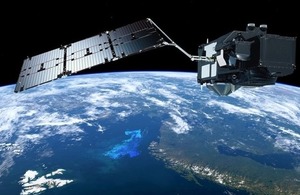UK celebrates launch of climate and ocean-monitoring satellite
The UK’s routine access to important environmental data is set to take a major step forward following launch of EU satellite Sentinel-3A.

Artist's impression of Sentinel-3. Credit: ESA/ATG medialab.
The third satellite of Europe’s Copernicus programme will focus on Earth’s oceans, measuring the temperature, colour and sea levels.
UK space industry has played an important role in developing the mission’s Sea and Land Surface Temperature Radiometer (SLSTR), the Payload Data Ground Segment and components of hardware.
Copernicus
The European Space Agency’s Sentinels, a new fleet of Earth observation satellites, are poised to deliver a wealth of data and imagery that are central to the EU’s Copernicus programme.
UK involvement in Copernicus is through the Department for Environment, Food and Rural Affairs (Defra), whilst the UK Space Agency provides UK investment in the Sentinel satellites.
By offering a set of information services for a broad range of applications, the Copernicus global monitoring programme is a step change in the way we manage our environment, understand and tackle the effects of climate change, and safeguard everyday lives.
Apart from the government and academic uses, business users and the public will have access to a wide array of up to date and accurate satellite data and imagery for free. It is hoped that the free and open data policy will drive a vastly increased uptake in the use of space generated data.
Sentinel-3A
Sentinel-3A’s sensors will measure ocean features such as changes in water temperature and surface height – information needed for ocean forecasting and maritime safety. Around coasts, this is also important for predicting extreme events such as storm surges and floods.
Monitoring seawater quality and pollution, this multitalented satellite will also help to map the topography and extent of ice, and to monitor the height of lake and river water. Over land, its uses include detecting fires and mapping.
UK companies are planning to use the Sentinel-3A data as the backbone of a cost effective information service in a range of areas from flooding to agriculture and aquaculture. Sentinel-3A data will also be an important contributor to public services such as the Copernicus Climate Service and Copernicus Marine Service.
Additionally, the Met Office plans to use sea surface temperature data from the satellite to initialise their weather forecast models.
SLSTR data will also be carefully combined with SST from previous satellite instruments to measure changes across decades. These activities require major computing power, and the UK has created a facility for collecting and processing large volumes of SLSTR and other data, at Harwell. The National Centre for Earth Observation (NCEO) will use SLSTR to provide essential new information on the land, including fires and land surface temperature, and data to map the radiative heat emitted by fires burning worldwide.
The UK and Sentinel-3A
STFC’s RAL Space scientists and engineers have played a key role in the development of the SLSTR design, its calibration and the definition of the data products and processing algorithms.
Telespazio VEGA has been involved in the development of the Sentinel-3 Payload Data Ground Segment, in addition to developing specific components of the hardware and training the staff in readiness for operations. The company is also currently updating the data records of the precursor instruments (ATSR and AATSR) to the same standard as the Sentinel-3 SLSTR instrument. This will enable easier direct comparison of similar past data with that which will be acquired by the new Sentinel-3.
Airbus Defence and Space built the space coolers and ABSL built the blackbody calibration targets.